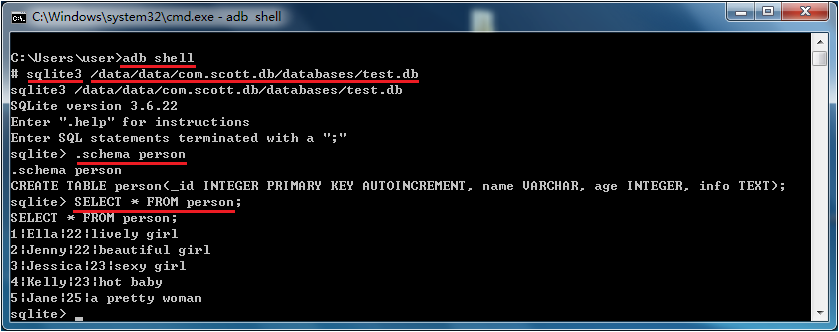现在的主流移动设备像Android、iPhone等都使用SQLite作为复杂数据的存储引擎,在我们为移动设备开发应用程序时,也许就要使用到SQLite来存储我们大量的数据,所以我们就需要掌握移动设备上的SQLite开发技巧。
对于Android平台来说,系统内置了丰富的API来供开发人员操作SQLite,我们可以轻松的完成对数据的存取。
下面就向大家介绍一下SQLite常用的操作方法,为了方便,我将代码写在了Activity的onCreate中:
1 @Override 2 protected void onCreate(Bundle savedInstanceState) { 3 super.onCreate(savedInstanceState); 4 5 //打开或创建test.db数据库 6 SQLiteDatabase db = openOrCreateDatabase("test.db", Context.MODE_PRIVATE, null); 7 db.execSQL("DROP TABLE IF EXISTS person"); 8 //创建person表 9 db.execSQL("CREATE TABLE person (_id INTEGER PRIMARY KEY AUTOINCREMENT, name VARCHAR, age SMALLINT)"); 10 Person person = new Person(); 11 person.name = "john"; 12 person.age = 30; 13 //插入数据 14 db.execSQL("INSERT INTO person VALUES (NULL, ?, ?)", new Object[]{person.name, person.age}); 15 16 person.name = "david"; 17 person.age = 33; 18 //ContentValues以键值对的形式存放数据 19 ContentValues cv = new ContentValues(); 20 cv.put("name", person.name); 21 cv.put("age", person.age); 22 //插入ContentValues中的数据 23 db.insert("person", null, cv); 24 25 cv = new ContentValues(); 26 cv.put("age", 35); 27 //更新数据 28 db.update("person", cv, "name = ?", new String[]{"john"}); 29 30 Cursor c = db.rawQuery("SELECT * FROM person WHERE age >= ?", new String[]{"33"}); 31 while (c.moveToNext()) { 32 int _id = c.getInt(c.getColumnIndex("_id")); 33 String name = c.getString(c.getColumnIndex("name")); 34 int age = c.getInt(c.getColumnIndex("age")); 35 Log.i("db", "_id=>" + _id + ", name=>" + name + ", age=>" + age); 36 } 37 c.close(); 38 39 //删除数据 40 db.delete("person", "age < ?", new String[]{"35"}); 41 42 //关闭当前数据库 43 db.close(); 44 45 //删除test.db数据库 46 // deleteDatabase("test.db"); 47 }
在执行完上面的代码后,系统就会在/data/data/[PACKAGE_NAME]/databases目录下生成一个“test.db”的数据库文件,如图:

上面的代码中基本上囊括了大部分的数据库操作;对于添加、更新和删除来说,我们都可以使用
除了统一的形式之外,他们还有各自的操作方法:
以上三个方法的第一个参数都是表示要操作的表名;insert中的第二个参数表示如果插入的数据每一列都为空的话,需要指定此行中某一列的名称,系统将此列设置为NULL,不至于出现错误;insert中的第三个参数是ContentValues类型的变量,是键值对组成的Map,key代表列名,value代表该列要插入的值;update的第二个参数也很类似,只不过它是更新该字段key为最新的value值,第三个参数whereClause表示WHERE表达式,比如“age > ? and age < ?”等,最后的whereArgs参数是占位符的实际参数值;delete方法的参数也是一样。
下面来说说查询操作。查询操作相对于上面的几种操作要复杂些,因为我们经常要面对着各种各样的查询条件,所以系统也考虑到这种复杂性,为我们提供了较为丰富的查询形式:
-
1 db.rawQuery(String sql, String[] selectionArgs); 2 db.query(String table, String[] columns, String selection, String[] selectionArgs, String groupBy, String having, String orderBy); 3 db.query(String table, String[] columns, String selection, String[] selectionArgs, String groupBy, String having, String orderBy, String limit); 4 db.query(String distinct, String table, String[] columns, String selection, String[] selectionArgs, String groupBy, String having, String orderBy, String limit);
上面几种都是常用的查询方法,第一种最为简单,将所有的SQL语句都组织到一个字符串中,使用占位符代替实际参数,selectionArgs就是占位符实际参数集;下面的几种参数都很类似,columns表示要查询的列所有名称集,selection表示WHERE之后的条件语句,可以使用占位符,groupBy指定分组的列名,having指定分组条件,配合groupBy使用,orderBy指定排序的列名,limit指定分页参数,distinct可以指定“true”或“false”表示要不要过滤重复值。需要注意的是,selection、groupBy、having、orderBy、limit这几个参数中不包括“WHERE”、“GROUP BY”、“HAVING”、“ORDER BY”、“LIMIT”等SQL关键字。
最后,他们同时返回一个Cursor对象,代表数据集的游标,有点类似于JavaSE中的ResultSet。
下面是Cursor对象的常用方法:
-
1 c.move(int offset); //以当前位置为参考,移动到指定行 2 c.moveToFirst(); //移动到第一行 3 c.moveToLast(); //移动到最后一行 4 c.moveToPosition(int position); //移动到指定行 5 c.moveToPrevious(); //移动到前一行 6 c.moveToNext(); //移动到下一行 7 c.isFirst(); //是否指向第一条 8 c.isLast(); //是否指向最后一条 9 c.isBeforeFirst(); //是否指向第一条之前 10 c.isAfterLast(); //是否指向最后一条之后 11 c.isNull(int columnIndex); //指定列是否为空(列基数为0) 12 c.isClosed(); //游标是否已关闭 13 c.getCount(); //总数据项数 14 c.getPosition(); //返回当前游标所指向的行数 15 c.getColumnIndex(String columnName);//返回某列名对应的列索引值 16 c.getString(int columnIndex); //返回当前行指定列的值
在上面的代码示例中,已经用到了这几个常用方法中的一些,关于更多的信息,大家可以参考官方文档中的说明。
最后当我们完成了对数据库的操作后,记得调用SQLiteDatabase的close()方法释放数据库连接,否则容易出现SQLiteException。
上面就是SQLite的基本应用,但在实际开发中,为了能够更好的管理和维护数据库,我们会封装一个继承自SQLiteOpenHelper类的数据库操作类,然后以这个类为基础,再封装我们的业务逻辑方法。
下面,我们就以一个实例来讲解具体的用法,我们新建一个名为db的项目,结构如下:

其中DBHelper继承了SQLiteOpenHelper,作为维护和管理数据库的基类,DBManager是建立在DBHelper之上,封装了常用的业务方法,Person是我们的person表对应的JavaBean,MainActivity就是我们显示的界面。
下面我们先来看一下DBHelper:
正如上面所述,数据库第一次创建时onCreate方法会被调用,我们可以执行创建表的语句,当系统发现版本变化之后,会调用onUpgrade方法,我们可以执行修改表结构等语句。
为了方便我们面向对象的使用数据,我们建一个Person类,对应person表中的字段,如下:
然后,我们需要一个DBManager,来封装我们所有的业务方法,代码如下:
我们在DBManager构造方法中实例化DBHelper并获取一个SQLiteDatabase对象,作为整个应用的数据库实例;在添加多个Person信息时,我们采用了事务处理,确保数据完整性;最后我们提供了一个closeDB方法,释放数据库资源,这一个步骤在我们整个应用关闭时执行,这个环节容易被忘记,所以朋友们要注意。
我们获取数据库实例时使用了getWritableDatabase()方法,也许朋友们会有疑问,在getWritableDatabase()和getReadableDatabase()中,你为什么选择前者作为整个应用的数据库实例呢?在这里我想和大家着重分析一下这一点。
我们来看一下SQLiteOpenHelper中的getReadableDatabase()方法:
在getReadableDatabase()方法中,首先判断是否已存在数据库实例并且是打开状态,如果是,则直接返回该实例,否则试图获取一个可读写模式的数据库实例,如果遇到磁盘空间已满等情况获取失败的话,再以只读模式打开数据库,获取数据库实例并返回,然后为mDatabase赋值为最新打开的数据库实例。既然有可能调用到getWritableDatabase()方法,我们就要看一下了:
-
1 public synchronized SQLiteDatabase getWritableDatabase() { 2 if (mDatabase != null && mDatabase.isOpen() && !mDatabase.isReadOnly()) { 3 // 如果mDatabase不为空已打开并且不是只读模式 则返回该实例 4 return mDatabase; 5 } 6 7 if (mIsInitializing) { 8 throw new IllegalStateException("getWritableDatabase called recursively"); 9 } 10 11 // If we have a read-only database open, someone could be using it 12 // (though they shouldn't), which would cause a lock to be held on 13 // the file, and our attempts to open the database read-write would 14 // fail waiting for the file lock. To prevent that, we acquire the 15 // lock on the read-only database, which shuts out other users. 16 17 boolean success = false; 18 SQLiteDatabase db = null; 19 // 如果mDatabase不为空则加锁 阻止其他的操作 20 if (mDatabase != null) 21 mDatabase.lock(); 22 try { 23 mIsInitializing = true; 24 if (mName == null) { 25 db = SQLiteDatabase.create(null); 26 } else { 27 // 打开或创建数据库 28 db = mContext.openOrCreateDatabase(mName, 0, mFactory); 29 } 30 // 获取数据库版本(如果刚创建的数据库,版本为0) 31 int version = db.getVersion(); 32 // 比较版本(我们代码中的版本mNewVersion为1) 33 if (version != mNewVersion) { 34 db.beginTransaction();// 开始事务 35 try { 36 if (version == 0) { 37 // 执行我们的onCreate方法 38 onCreate(db); 39 } else { 40 // 如果我们应用升级了mNewVersion为2,而原版本为1则执行onUpgrade方法 41 onUpgrade(db, version, mNewVersion); 42 } 43 db.setVersion(mNewVersion);// 设置最新版本 44 db.setTransactionSuccessful();// 设置事务成功 45 } finally { 46 db.endTransaction();// 结束事务 47 } 48 } 49 50 onOpen(db); 51 success = true; 52 return db;// 返回可读写模式的数据库实例 53 } finally { 54 mIsInitializing = false; 55 if (success) { 56 // 打开成功 57 if (mDatabase != null) { 58 // 如果mDatabase有值则先关闭 59 try { 60 mDatabase.close(); 61 } catch (Exception e) { 62 } 63 mDatabase.unlock();// 解锁 64 } 65 mDatabase = db;// 赋值给mDatabase 66 } else { 67 // 打开失败的情况:解锁、关闭 68 if (mDatabase != null) 69 mDatabase.unlock(); 70 if (db != null) 71 db.close(); 72 } 73 } 74 }
大家可以看到,几个关键步骤是,首先判断mDatabase如果不为空已打开并不是只读模式则直接返回,否则如果mDatabase不为空则加锁,然后开始打开或创建数据库,比较版本,根据版本号来调用相应的方法,为数据库设置新版本号,最后释放旧的不为空的mDatabase并解锁,把新打开的数据库实例赋予mDatabase,并返回最新实例。
看完上面的过程之后,大家或许就清楚了许多,如果不是在遇到磁盘空间已满等情况,getReadableDatabase()一般都会返回和getWritableDatabase()一样的数据库实例,所以我们在DBManager构造方法中使用getWritableDatabase()获取整个应用所使用的数据库实例是可行的。当然如果你真的担心这种情况会发生,那么你可以先用getWritableDatabase()获取数据实例,如果遇到异常,再试图用getReadableDatabase()获取实例,当然这个时候你获取的实例只能读不能写了。
最后,让我们看一下如何使用这些数据操作方法来显示数据,下面是MainActivity.Java的布局文件和代码:
这里需要注意的是SimpleCursorAdapter的应用,当我们使用这个适配器时,我们必须先得到一个Cursor对象,这里面有几个问题:如何管理Cursor的生命周期,如果包装Cursor,Cursor结果集都需要注意什么。
如果手动去管理Cursor的话会非常的麻烦,还有一定的风险,处理不当的话运行期间就会出现异常,幸好Activity为我们提供了startManagingCursor(Cursor cursor)方法,它会根据Activity的生命周期去管理当前的Cursor对象,下面是该方法的说明:
-
1 /** 2 * This method allows the activity to take care of managing the given 3 * {@link Cursor}'s lifecycle for you based on the activity's lifecycle. 4 * That is, when the activity is stopped it will automatically call 5 * {@link Cursor#deactivate} on the given Cursor, and when it is later restarted 6 * it will call {@link Cursor#requery} for you. When the activity is 7 * destroyed, all managed Cursors will be closed automatically. 8 * 9 * @param c The Cursor to be managed. 10 * 11 * @see #managedQuery(android.net.Uri , String[], String, String[], String) 12 * @see #stopManagingCursor 13 */
文中提到,startManagingCursor方法会根据Activity的生命周期去管理当前的Cursor对象的生命周期,就是说当Activity停止时他会自动调用Cursor的deactivate方法,禁用游标,当Activity重新回到屏幕时它会调用Cursor的requery方法再次查询,当Activity摧毁时,被管理的Cursor都会自动关闭释放。
如何包装Cursor:我们会使用到CursorWrapper对象去包装我们的Cursor对象,实现我们需要的数据转换工作,这个CursorWrapper实际上是实现了Cursor接口。我们查询获取到的Cursor其实是Cursor的引用,而系统实际返回给我们的必然是Cursor接口的一个实现类的对象实例,我们用CursorWrapper包装这个实例,然后再使用SimpleCursorAdapter将结果显示到列表上。
Cursor结果集需要注意些什么:一个最需要注意的是,在我们的结果集中必须要包含一个“_id”的列,否则SimpleCursorAdapter就会翻脸不认人,为什么一定要这样呢?因为这源于SQLite的规范,主键以“_id”为标准。解决办法有三:第一,建表时根据规范去做;第二,查询时用别名,例如:SELECT id AS _id FROM person;第三,在CursorWrapper里做文章:
如果试图从CursorWrapper里获取“_id”对应的列索引,我们就返回查询结果里“id”对应的列索引即可。
最后我们来看一下结果如何:

